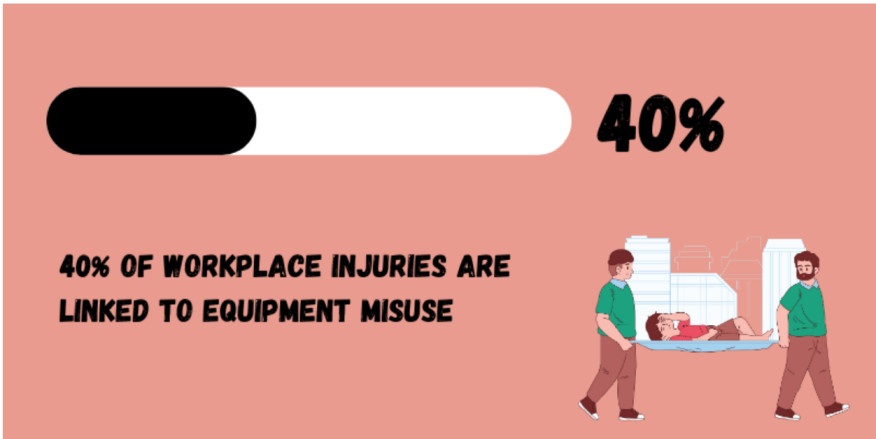5 Common Equipment Management Mistakes (and How SMBs Can Avoid Them)
Are you making costly equipment management mistakes in your small business? Discover five common errors and learn simple ways SMBs can avoid them.
In this article:
- Key Takeaways: Equipment Management Mistakes
- Mistake 1: Relying on Manual Tracking Systems
- How to Avoid Manual Tracking Mistakes
- Mistake 2: Poor Maintenance Scheduling
- How to Avoid Poor Maintenance Scheduling
- Mistake 3: Ignoring Equipment Utilization Data
- How to Use Utilization Data
- Mistake 4: Lack of Employee Training
- How to Train Employees
- Mistake 5: Not Having a Centralized Equipment Management System
- How To Avoid the Hassle of Multiple Systems
- Summing Up

Did you know that nearly 43% of small businesses struggle with tracking equipment and inventory effectively? That’s a considerable number.
But the challenges don’t stop here.
This poor management of tools and assets consumes time, creates financial strain, and results in productivity losses. More importantly, these are some of the equipment management mistakes that SMBs cannot afford.
Let’s take a closer look at these equipment management mistakes and how SMBs can avoid them.
Key Takeaways: Equipment Management Mistakes
- Mistake 1: Companies still rely on manual spreadsheets and paper logs, which lead to duplicate records, misplaced equipment, and wasted time.
- Mistake 2: Most SMBs wait until the equipment breaks down, resulting in higher repair costs and costly project delays.
- Mistake 3: Businesses fail to track usage. This leads to overbuying some assets while underusing others, thus draining their budgets.
- Mistake 4: Not providing proper training to the employees. Without it, employees misuse equipment, which increases safety risks.
- Mistake 5: SMBs use scattered data across tools and emails. This makes it hard to see the whole picture and creates inefficiency.
Mistake 1: Relying on Manual Tracking Systems
One of the most common equipment management mistakes is that many SMBs still rely on manual spreadsheets. At first, it may seem cost-effective, but manual tracking quickly becomes a liability as the business grows.
Moreover, human error is the biggest problem here. In fact, 88% of spreadsheets contain errors, mainly because of simple human typos, missed updates, or incorrect formulas. For SMBs, those mistakes often translate to misplaced equipment and downtime.

Source: Monograph
A Reddit thread on r/smallbusiness even highlights this frustration, with one owner calling it “Excel chaos”.
How to Avoid Manual Tracking Mistakes
Adopt a cloud-based equipment management software. Unlike spreadsheets, these platforms update in real-time, reduce duplication errors, and make information accessible from anywhere.
They also include features like barcoding, RFID scanning, and mobile check-in/check-out, which help businesses track the location of each asset.
Mistake 2: Poor Maintenance Scheduling
Another trap in which SMBs commonly fall is waiting until equipment breaks before fixing it. This “run-to-failure” approach feels cheaper in the short term, but it usually costs far more in the long run.
Studies also show that unplanned repairs are up to 5 times more expensive than preventive maintenance. It includes the costs of lost productivity and missed deadlines as well.
How to Avoid Poor Maintenance Scheduling
Setting up a maintenance schedule with digital alerts, checklists, and responsibility assignments ensures that no equipment gets overlooked.
You can also use modern management software that makes this entire process easier. They also send automated reminders of when maintenance is due, and you can add equipment maintenance logs to it for safekeeping.
Mistake 3: Ignoring Equipment Utilization Data
One big mistake SMBs make is not tracking how often equipment is actually used. Without utilization data, businesses usually end up overbuying some assets while underusing others. This wastes money and makes it harder to justify equipment budgets.
Research shows that companies lose up to 20% of their total equipment value annually because of poor utilization tracking. For SMBs with tighter budgets, this can mean thousands of dollars in unnecessary costs.

How to Use Utilization Data
Simply, implement asset tracking software that monitors usage hours, mileage, or active time. This helps managers identify underused equipment that could be redeployed, rented out, or even sold.
You can also use cloud-based tools to generate reports and forecast future needs more accurately. By paying attention to real usage data, SMBs can make sharper financial decisions.
Mistake 4: Lack of Employee Training
Even the best equipment won’t perform well if employees don’t know how to use it properly. One of the most common equipment management mistakes SMBs make is skipping formal training. Instead, they rely on quick instructions or assume staff will “figure it out.”
This leads to misuse, safety risks, and faster equipment wear and tear. Interestingly, nearly 40% of workplace injuries are linked to equipment misuse or improper handling. And it’s all because of a lack of employee training.

How to Train Employees
Build a structured training program. Even simple video tutorials, manufacturer-led workshops, or digital knowledge bases can go a long way. Some SMBs are now using mobile apps with built-in training modules so that employees can access instructions directly on the job.
With proper training, employees not only work more, but also extend the lifespan of equipment and reduce repair costs.
Mistake 5: Not Having a Centralized Equipment Management System
Many SMBs scatter their equipment data across different tools, emails, or even personal notes. It makes it nearly impossible to get a clear, real-time view of asset health, usage, and costs. Without it, managers often waste hours tracking down who has last used a piece of equipment.
Moreover, lack of centralization impacts financial accuracy and costs businesses significantly. On the productivity front, companies that use centralized systems report less downtime compared to fragmented systems.
How To Avoid the Hassle of Multiple Systems
The answer is to adopt a centralized equipment management system that consolidates all data in one place. Modern platforms include features like:
- Real-time equipment tracking with GPS
- Automatic asset maintenance alerts
- Role-based access for staff
It reduces confusion and saves money by preventing double-purchasing and catching issues early.
Summing Up
Avoiding common equipment management mistakes can save SMBs significant time and money. Most problems happen because of poor tracking, lack of maintenance planning, or inadequate tool use.
The good news is that small changes, like adopting cloud-based inventory management systems and creating preventive schedules, can make a big difference.
With the right approach, your equipment will last longer, projects will run smoothly, and your business will avoid unnecessary losses.
Frequently Asked Questions
-
Small equipment like drills, ladders, or safety gear often gets misplaced. Instead of manual logs, use barcode or QR codes that can be scanned quickly on-site. Some businesses also use tool lockers with digital access records to further prevent loss or misuse.
-
Loss and theft are common for SMBs, especially with mobile tools or job site machinery. The best step is prevention: GPS tracking, barcode scans, and check-in/out records. If something is missing, your system’s usage log will quickly identify the last user or location.
-
You must always have a backup plan in place. Maintain a small pool of standby equipment or rental agreements. Moreover, use your asset system to mark units under repair and instantly allocate replacements so work can continue with zero downtime.
